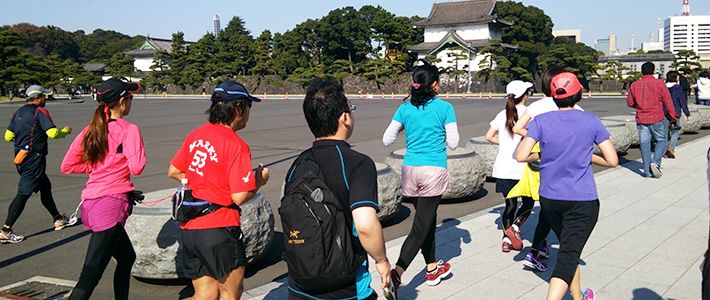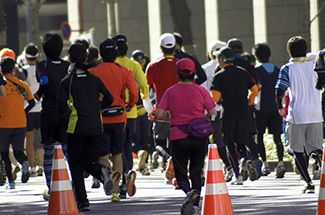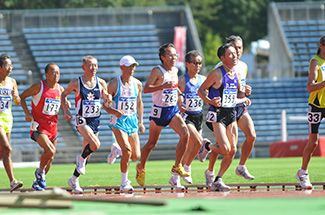
Running Around the Imperial Palace
Society Culture- English
- 日本語
- 简体字
- 繁體字
- Français
- Español
- العربية
- Русский
City Workers Get Some Exercise
The Imperial Palace in Tokyo includes the residence of the emperor, the Kyūden or main palace building, the Kyūchū-sanden (three palace sanctuaries) where ceremonies are conducted, and the headquarters of the Imperial Household Agency, which administers matters relating to the imperial family. It is built on the site of the Edo Castle complex, which was the political center of Japan during the Edo period (1603–1868).
The palace has nine gates: Seimon, Sakuradamon, Hanzōmon, Inuimon, Kita-hanebashimon, Hirakawamon, Ōtemon, Kikyōmon, and Sakashitamon. The main Seimon entrance leads to Nijūbashi, the bridge used by members of the imperial family and foreign dignitaries.
The distance around the Imperial Palace moat is roughly 5 kilometers. It is one of the capital's most popular jogging courses. On weekday lunchtimes, many employees at nearby companies and government offices work up a sweat and shake off the lethargy of deskbound life with a circuit or more. Some local sports clubs oversee long-distance runs around the moated compound. On weekends and holidays, the broad roads around Nijūbashimae and Uchibori-dōri are closed to vehicles and taken over by eager runners and cyclists, and sometimes official races are held. Crown Prince Naruhito has even been seen jogging in the vicinity.
Taking in the Sights While Running
Access to the Imperial Palace Grounds
Part of the palace grounds is open to the general public. The Higashi-Gyoen, or East Gardens of the Imperial Palace, is located where the innermost part (honmaru) of Edo Castle used to be. Nearby is the lush greenery of Kitanomaru Park, which is home to the National Museum of Modern Art, Tokyo.
 Runners making a circuit of the Imperial Palace.
Runners making a circuit of the Imperial Palace.
The outer moat for the original castle town stretched for 14 kilometers, encompassing what is now Tokyo Station, but was largely filled in during the development of the city. The remaining moat, walls, gates, and towers summon up the past atmosphere of Edo Castle and have been designated a special historic site by the national government. The imperial family now lives in part of the Fukiage garden area.
Runners circling the Imperial Palace can feast their eyes on the Nijūbashi Bridge, sections of Edo Castle, the National Museum of Modern Art, the building of the National Diet, the majestic British Embassy, the Metropolitan Police Department headquarters, and the red bricks of various ministries and Tokyo Station.
The 2.5-kilometer half-circuit from Ōtemon, near Tokyo Station, to Hanzōmon is one route particularly favored by runners for its gentle slope and lack of traffic lights.
Links:Visiting the palace and participating in public events
Tokyo Free Walking Tour
Higashi-Gyoen (East Gardens of the Imperial Palace)
- Free admission.
- Open all year round, except the following days and dates.
Mondays and Fridays. The gardens open on Mondays that are national holidays, however (except the Emperor’s Birthday on December 23), in which case they are closed on the following Tuesday.
From December 28 to January 3.
The gardens may also be closed due to imperial court functions and on other necessary occasions. - Opening hours.
March 1–14, September 1 to October 31: 9:00 am–4:30 pm (last entry 4:00 pm)
April 15 to August 31: 9:00 am–5:00 pm (last entry 4:30 pm)
November 1 to last day of February: 9:00 am–4:00 pm (last entry 3:30 pm)
Nearby Showers and Changing Rooms
- Marunouchi Bike & Run
B1F Shin-Marunouchi Building, 1-5-1 Marunouchi, Chiyoda-ku, Tokyo
Tel: 03-6269-9806 http://www.bike-run.jp/run-en - Runners Station Kōjimachi
4-8-1 Kōjimachi, Chiyoda-ku, Tokyo
Tel: 03-5275-0089 http://www.runsta.jp/ (Japanese) http://www.runsta.jp/shared/images/how_to_runsta.pdf (English)
(Banner photo: A crowd of runners between Kikyōmon and Ōtemon. In the background, the tatsumi-yagura, or southeast tower, can be seen.)
Photo credit:Runners and greenery: mrhayata▼Further reading
 Running: It’s a Lifestyle Running: It’s a Lifestyle |  Aged Athletics: Seniors Show a Surprising Turn of Speed Aged Athletics: Seniors Show a Surprising Turn of Speed |
sports running Imperial Palace jogging Higashi Gyoen Edo Castle
